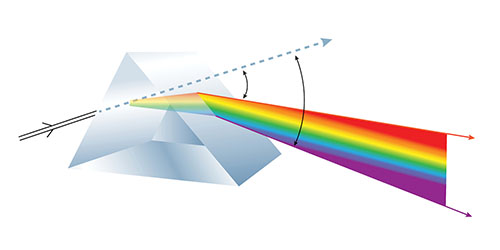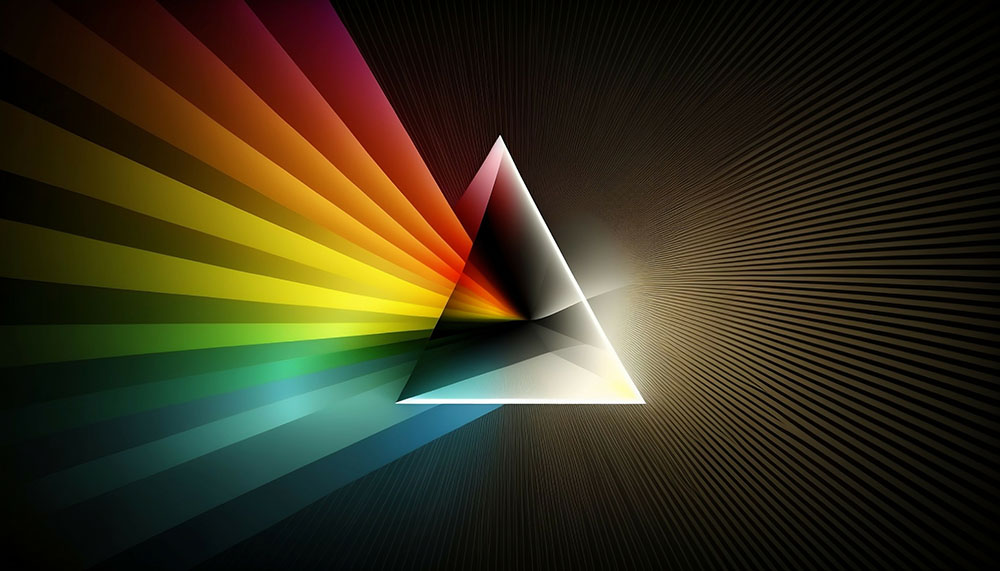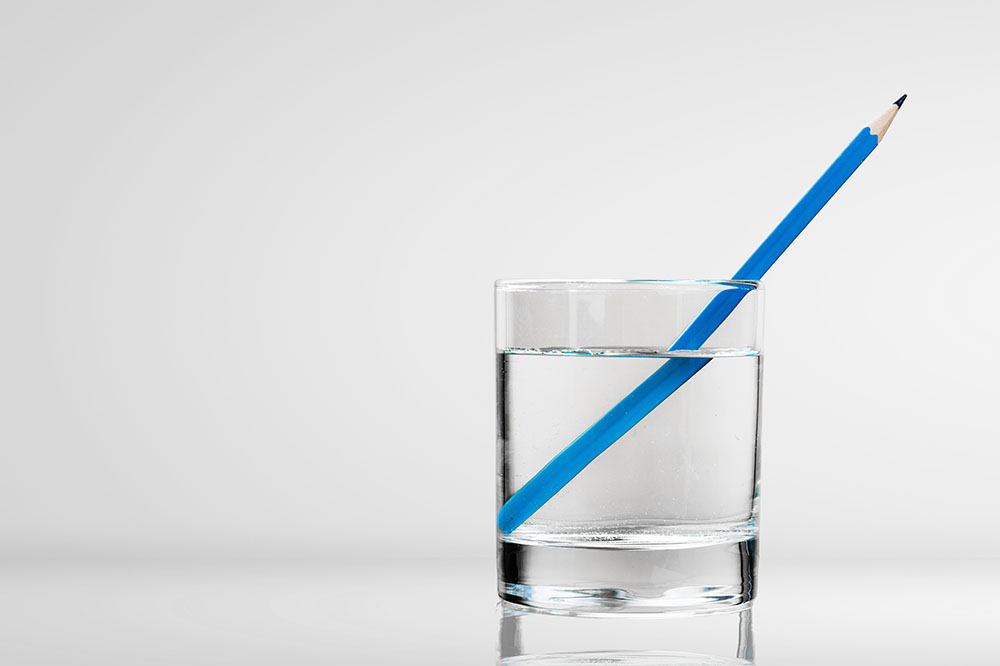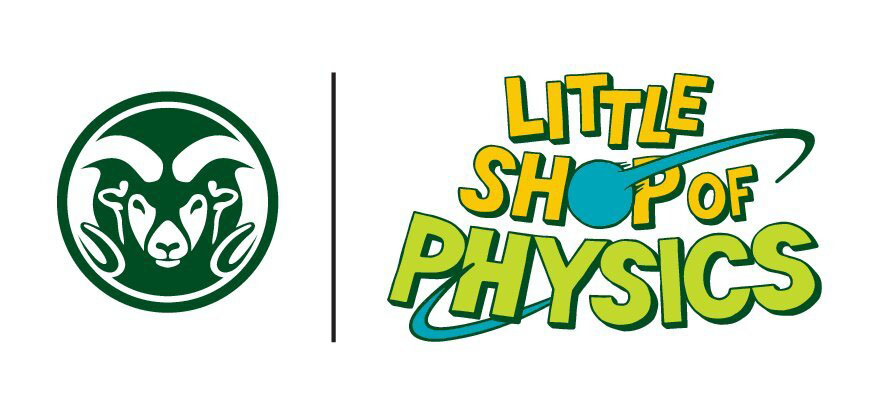Chroma Depth Glasses
Experimenting with wave properties of light
Total Time: 30 - 45 minutes
Audience: Middle School Science Teachers
Education Level: Grades 5 - 9
Content Area: Waves
Educational Topic: Waves, features of waves, wave terminology
Objectives: Students will use ChromaDepth glasses which bend light of different wavelengths by different amounts. Students will experiment by looking at different objects with the glasses on, create ChromaDepth art, and brainstorm possible applications of ChromaDepth technology.
Key Question: What is wave diffraction? Wave refraction? Name examples of wave diffraction and refraction you see in real life. How can ChromaDepth possibly play into new technologies?

Next Generation Science Standards
MS-PS4-2. Develop and use a model to describe that waves are reflected, absorbed, or transmitted through various materials.
CCC: Influence of Science, Engineering, and Technology on Society and the Natural World ▪ Technologies extend the measurement, exploration, modeling, and computational capacity of scientific investigations. (MS-PS4-3)
CCC: Science is a Human Endeavor ▪ Advances in technology influence the progress of science and science has influenced advances in technology. (MS-PS4-3)
SEPs: Scientific knowledge is based on empirical evidence ▪ Scientific knowledge is based upon logical and conceptual connections between evidence and explanations. (MS-PS4-1)
Materials
- ChromaDepth glasses
- Colorful fabric, images, etc. (We’ve found that bright primary colors on dark backgrounds work best)
- Black paper and colorful gel pens, paint markers, or similar drawing implements to create ChromaDepth art
Overview: Students start by exploring different light sources using ChromaDepth glasses. Encourage students to look at different colorful fabrics, objects, posters on your walls, or Google “Chromadepth art” and look at various pictures online that give a good 3D effect. Then, they can create “ChromaDepth art” — drawing with brightly-colored gel pens or paint markers on black paper. Finally, encourage students to think about real-life scenarios where ChromaDepth technology could be used.
Teacher’s Guide
Teacher Background
Watch this video from Little Shop of Physics for an overview of the experimental setup and the science behind the phenomenon!
The lenses of ChromaDepth glasses contain a very fine series of slits. Light passing through these slits will get spread out. In formal physics jargon, the lenses act as diffraction gratings: they diffract (spread out) light that passes through them. It’s worth noting that the grating in ChromaDepth glasses has a unique structure — the fine structure in these lenses is a bit different than a normal diffraction grating. The angle of diffraction depends on the wavelength (color) of the light.
The overall effect we are interested in is that the glasses diffract (bend) different wavelengths (colors) of light to different angles. The glasses bend red light to a greater angle than blue light (in-between colors, like green, are bent to in-between angles). Most people’s brains will interpret this difference in angles to mean that red areas are “floating” above a surface, and that blue areas are “sinking” into it.
Optical devices (like lenses, mirrors, prisms, diffraction gratings, etc.) use reflection, refraction, or diffraction to move light around. The optics found in ChromaDepth 3D glasses, combine refraction and diffraction to make thin optics that act like thick glass prisms; it’s like having a super compact version of a glass prism!
Key Terms (used or presented after the activities)
- Diffraction: Slight bending of a wave as it passes around the edges of an obstacle.
- Refraction: The bending of a wave as it travels from one material to another.
Objectives
Students will use ChromaDepth glasses which bend light of different wavelengths by different amounts. Students will experiment by looking at different objects with the glasses on, create ChromaDepth art, and brainstorm possible applications of ChromaDepth technology.*
*It is important to understand that student goals may be different and unique from the lesson goals. We recommend leaving room for students to set their own goals for each activity.
Before the Experiment
Teacher notes: Ask the students to wear brightly colored clothing for the day of the experiment.
Watch this video from Little Shop of Physics for an overview of the experimental setup and the science behind the phenomenon!
Ask & Discuss
Ask any or all of the following set-up questions: Have you ever stuck your arm in a swimming pool and noticed how it appears “broken” at the boundary between the water and the air above? Maybe you’ve seen something similar with a drinking straw sitting in a glass of water. Why do you think that happens? How about the rainbow effect you can see when looking at the back of a CD or DVD disc? What causes those rainbow colors to appear?
- Tell students that the experiment they are about to do will help them explore these properties of light waves.
Setting Up
- It is often helpful to have some fabrics or images on hand that you know will give a good effect when observed through the glasses; you’ll want to look for bright primary colors (reds, greens, and blues, though bright yellows and pinks also usually work) on dark backgrounds.
- Hand out one pair of ChromaDepth glasses per student.
During the Experiment
- These glasses lend themselves well to open-ended inquiry. Just put on a pair of glasses and explore!
- Note that the effect will be quite strong and apparent for most students but may be much weaker for some.
- Have students create “ChromaDepth art” — drawing with brightly-colored gel pens/paint markers on black paper. If you’re having trouble making this work with the gel pens, note that creating thicker lines and putting different-colored lines adjacent to one another tends to improve the effect.
- Introduce the PQ 23: Making Waves Physics Career and Concept Map and allow students to read through and discuss the careers that use this content. Extend their thinking with research about these careers if time allows.
Teacher Tips
- A great way to start any physics-related unit is with the STEP UP Careers in Physics lesson. This lesson covers careers that one can do with a physics degree, particularly those that help solve societal problems. It helps students assess their personal values in relation to a career in physics, examine profiles of professionals with physics degrees, and envision themselves in a physics career.
- Suggested STEP UP Everyday Actions to incorporate into activity:
- When pairing students, try to have male/female partners and invite female students to share their ideas first.
- As you put students into groups, consider having female or students from underrepresented backgrounds take the leadership role.
- Take note of female participation. If they seem to be taking direction and following along, elevate their voice by asking them a question about their experiment.
- Consider using whiteboards so students have time to work through their ideas and brainstorms before saying them out loud.
- As students experiment, roam around the room to listen in on discussion and notice experiment techniques. If needed, stop the class and call over to a certain group that has hit on an important concept.
- ***Consider using the RIP protocol (Research, Instruct, Plan) for lab group visits and conferring.
- ***Consider culturally responsive tools and strategies and/or open-ended reflection questions to help push student thinking, evidence tracking, and connections to their lives. Look for *** below to find suggested places to add.
Conclusion
- After experiencing how ChromaDepth glasses create a 3D effect by diffracting and refracting the light, creating the effect of red features “floating” and blue features “sinking,” ask the students to think of possible applications of this technology in real life.
- Have students make a poster or other form of representation of their idea.
- Set the posters up around the classroom, on the walls, or on tables.
- Have small groups of students travel from station to station together, looking at others’ ideas.
- You can have students respond using sticky notes with questions or wonderings.
Student’s Guide
Introduction
Now that we know a bit about waves, we’re going to focus on light waves in particular. Optical devices like lenses, mirrors, and fiber optic cables use reflection, refraction, or diffraction to move light around. You’re probably already familiar with reflection — it’s the bouncing of light off a surface. The optics found in the ChromaDepth glasses you’ll explore with today combine refraction and diffraction to bend light and create a 3D effect. You’ll get to explore this 3D effect, create 3D art, and come up with possible applications of using ChromaDepth technology elsewhere.
Objective: Students will use ChromaDepth glasses which bend light of different wavelengths by different amounts. Students will experiment by looking at different objects with the glasses on, create ChromaDepth art, and brainstorm possible applications of ChromaDepth technology.
Students: After reading the introduction, what is your essential question or objective for this activity?
:
Before the Experiment
- Wear brightly colored clothing to school tomorrow! Something with lots of colors and/or a really colorful pattern will be best!
Setting Up
- Get a pair of ChromaDepth glasses from your teacher.
During the Experiment***
Explore
- Explore the room, looking at fabrics, posters, and colorful objects.
- Can you rearrange anything on your desk to give you a powerful 3D effect? Try layering different colorful objects you have around you!
Extend
- Collect black paper and gel pens/paint markers from your teacher to create your own ChromaDepth art. Try using bold lines. What happens when you put certain colors next to each other?
Conclusion***
- Now that you've seen how ChromaDepth uses the diffraction and refraction of light to create a 3D effect where red features “float” and blue features “sink,” think up a possible further application of ChromaDepth technology!
- Explore the PQ 23: Making Waves Physics Career and Concept Map. What careers that use this content sound most appealing to you? Why?
Additional Resources
- https://www.lsop.colostate.edu/2016/01/08/everyday-science-light-and-color-part-6/
- https://www.lsop.colostate.edu/2015/12/18/everyday-science-light-and-color-part-3/
- Sign up for Physicists To-Go to have a scientist talk to your students.
- STEP UP Women in Physics lesson: Introduces the underrepresentation of women in physics and the role of implicit bias and cultural stereotypes. Helps students examine the conditions for women in physics and discuss gender issues, gendered professions, and personal experience to neutralize the effect of stereotypes and bias.
Assessment/Extension activities** (optional to extend thinking after the lesson)



- Real world connections:
- Based on what you learned in this activity, which of the following images is an example of reflection, refraction, and diffraction? (Suggested photos below)
- Suggestions for drawing, illustrating, and presenting content in creative ways:
- Create Mirror Reflection Art with students
- Engineering and design challenges connected to the content:
- How could you use the properties of lenses and mirrors to move around a beam of light? Brainstorm what kinds of systems might use this type of technology and how you can use it to solve a problem.
- If engineering challenges have a time constraint, students are allowed to keep iterating and developing their ideas outside of class time and continue to participate in the challenge at a later date
- Watch this Listen to Light video and see what lasers sound like!
**Real-world situations/connections can be used as is, or changed to better fit a student’s own community and cultural context.
Credits

Reviewed by Summer Chrisman, MEd, Tamia Williams, MSt, Chris Irwin
Extensions by Jenna Tempkin
Formatted by Sierra Crandell, MEd, partially funded by Eucalyptus Foundation PhysicsQuest © 2023 by American Physical Society is licensed under CC BY-NC 4.0
